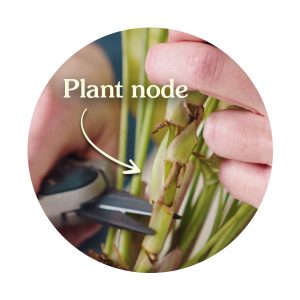Propagating houseplants is a great way to save money. It can be rewarding and is the perfect solution to expanding your houseplant collection, allowing you to learn more about your plants along the way. Our guide will walk you through the basics of plant propagation, ensuring your new plants thrive.
What is plant propagating?
Plant propagation is the process of creating new plants from a variety of sources: seeds, cuttings, and other plant parts. For houseplants, the most common methods are cuttings, division, and offsets. Understanding these methods can help you choose the best approach for each type of plant.

When is the best time to propagate houseplants?
You can propagate houseplants at any time of the year however spring is considered the best time to propagate most houseplants as they enter their active growing phase. Longer daylight hours and warmer temperatures will help stimulate vigorous growth. Plants are naturally inclined to grow during this season helping with root development. Optimal conditions are required which include increased sunlight and warmth support for new plants.
Early summer is also a favorable time to propagate. The warmer temperatures and abundant light provide excellent conditions, however, be cautious of warmer temperatures as extremely hot periods can distress new plants. Avoid propagating in peak heat, to prevent wilting. Ensure consistent watering practices as the summer heat can dry out soil quickly and provide indirect light or partial shade to prevent scorching.
What can I propagate?
There are many well known houseplants that are good for propagating, choosing a plant that is healthy and free from pests and diseases is important.
Tools you will need
- Sharp scissors, snips, sharp knife. We recommend Kent & Stowe Snips
- Small pots
- Glass jar
- Westland Houseplant Potting Mix or Westland Cacti & Succulent Potting Mix
- Indoor watering can, we recommend Kent & Stowe Indoor Watering Cans
- Mister
Propagating houseplants: Stem cuttings
Stem cuttings is one of the most effective ways to propagate houseplants. It is a simple method which involves cutting a section of stem from the parent plant, removing lower leaves and planting it in either fresh potting mix or in water in a glass jar. The cutting will begin to develop its own roots and eventually grow into a brand new plant. This method is useful for plants that have become too large, allowing you to take control.
Plants to use: Pothos, Philodendron, Monstera, Spider Plant
- Find the node of the plant and snip just below it
- Remove the lower leaves to expose the node
- Place the stem in a glass or jar of clean water (Optional Planting Tip! – Dip the stem in Westland Rooting Powder and place in fresh, moistened potting mix)
- If any leaves are dipping underwater, chop them off otherwise they will rot
- Leave the glass jar near a light source until roots develop
- Once the stem has developed roots, plant it in soil and watch it grow!
Propagating houseplants: Leaf cuttings
Plants to use: Snake Plant
- Cut a piece of a leaf from your plant
- Leave it somewhere dry for 48 hours, so the cut edge hardens
- Plant it in soil and put it near a light source
- Mist the soil regularly so it doesn’t dry out
- Wait for your plant to grow
Propagating houseplants: Division
Division is when you tear your plant’s root ball into multiple pieces and repot each piece to become its own plant. They need to be healthy, mature plants. You may want to do this outside or over some newspaper as it can get messy.
Plants to use: Snake plant, Peace Lily
- Remove your plant from its pot to expose the roots
- Carefully split the root ball with your hands (or use a sharp, clean knife for harder, more compacted root balls) into smaller sections so you have multiple plants, ensuring each has roots
- Pot up each divided plant in a new pot with fresh potting mix
- Water as normal
Propagating houseplants: Offsets
With this kind of propagation the plant does most of the work for you. Offsets are also known as ‘pups’. They’re miniature versions of the plant you’ll see growing from things like aloe vera, snake plants or spider plants. They may appear in the soil next to a ‘mother’ plant or hang off the mother plant on a long stem.

You should only remove offsets that already look like mini plants, not ones that are just developing.
- Cut off the offset using a sharp, clean knife, or just gently wiggle it free
- Clean off any soil using clean tepid water
- Place it somewhere cool and let your offset dry for 48 hours
- Pot your offset in soil and water as normal
Aftercare
Once your cuttings or divisions have started to develop roots, the right care is essential. Ensure they receive plenty of indirect sunlight. Keep the soil consistently moist but not waterlogged. Many houseplants thrive in humid environments, consider misting them regularly.
Propagating houseplants is a fulfilling and straightforward way to enhance your indoor jungle. With the right tools, techniques, and a bit of patience, you can enjoy multiple new houseplants without spending money. You may even consider gifting your new plants to family and friends!




